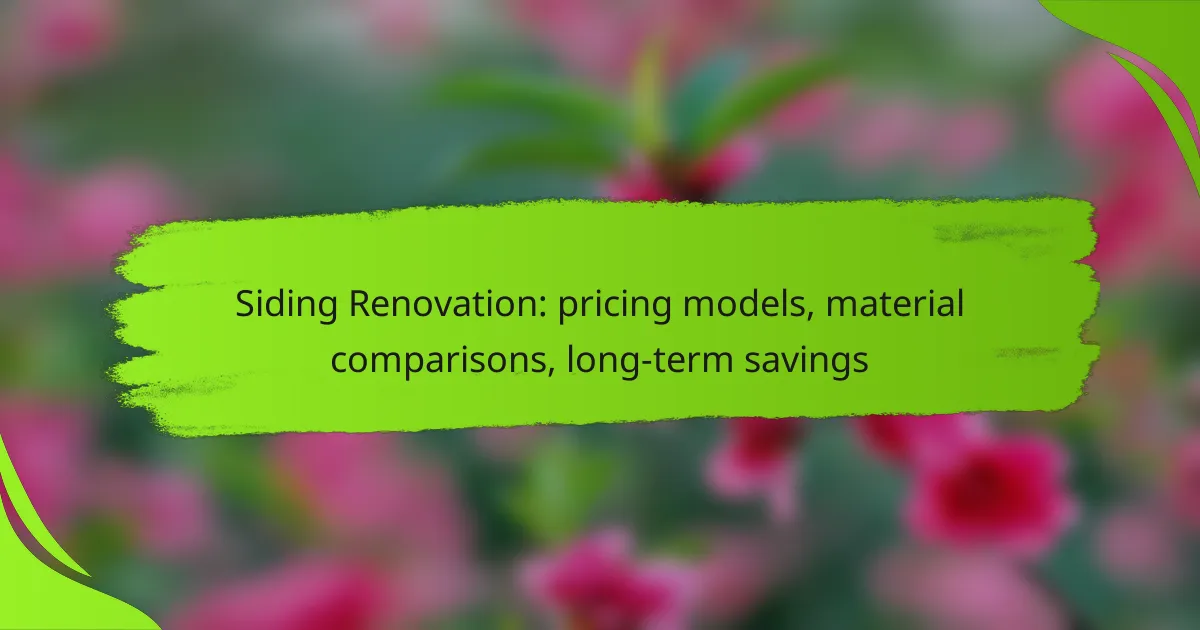Siding renovation is a significant investment, and understanding pricing models is essential for homeowners to budget effectively. By comparing materials like vinyl, wood, and fiber cement, homeowners can make informed choices that align with their financial and aesthetic goals. Selecting the right siding not only enhances curb appeal but also contributes to long-term savings through improved durability and reduced maintenance costs.

What are the siding renovation pricing models?
Siding renovation pricing models typically include cost per square foot, average total project cost, and financing options. Understanding these models helps homeowners budget effectively and choose the best materials for their renovation needs.
Cost per square foot
The cost per square foot for siding renovation varies based on material type and regional labor rates. Generally, homeowners can expect to pay anywhere from $3 to $15 per square foot, with vinyl siding often being the most affordable option and wood or fiber cement siding on the higher end.
When calculating costs, consider the total area to be covered and any additional expenses such as insulation or removal of old siding. This will provide a clearer picture of the overall financial commitment.
Average total project cost
The average total project cost for siding renovation can range from a few thousand to over $15,000, depending on the size of the home and the materials chosen. For example, a standard single-family home may incur costs between $7,000 and $12,000 for a complete siding replacement.
Keep in mind that these figures can fluctuate based on local market conditions, so obtaining multiple quotes from contractors is advisable to ensure competitive pricing.
Financing options
Homeowners have several financing options available for siding renovations, including personal loans, home equity loans, and contractor financing plans. Personal loans typically offer fixed rates and terms, making them a straightforward choice for many.
Home equity loans can provide larger amounts at lower interest rates, but they require sufficient equity in the home. Additionally, some contractors may offer financing plans that allow for payment over time, which can ease the immediate financial burden.

What are the best siding materials for renovation?
The best siding materials for renovation include vinyl, wood, and fiber cement, each offering unique benefits and considerations. Choosing the right material depends on factors like budget, climate, and desired aesthetics.
Vinyl siding benefits
Vinyl siding is popular due to its affordability and low maintenance requirements. It typically costs between $2 to $7 per square foot, making it a budget-friendly option for many homeowners.
This material is resistant to rot, insects, and fading, which can lead to long-term savings on repairs and repainting. Additionally, vinyl siding comes in a variety of colors and styles, allowing for customization to fit different architectural designs.
Wood siding advantages
Wood siding offers a classic, natural look that many homeowners find appealing. It generally ranges from $3 to $10 per square foot, depending on the type of wood and finish.
While wood can provide excellent insulation and aesthetic value, it requires regular maintenance, including painting or staining every few years to prevent rot and insect damage. This ongoing upkeep can add to the overall cost over time.
Fiber cement siding features
Fiber cement siding is known for its durability and resistance to harsh weather conditions. Priced between $5 to $10 per square foot, it combines the appearance of wood with the resilience of cement.
This material is fire-resistant and does not warp or crack easily, making it a long-term investment. However, installation can be more labor-intensive, which may increase initial costs. Homeowners should consider these factors when evaluating fiber cement for their renovation projects.

How do siding materials compare in terms of durability?
Siding materials vary significantly in durability, impacting their lifespan and maintenance needs. Choosing the right material can lead to long-term savings and reduced repair costs.
Vinyl vs. wood durability
Vinyl siding is known for its resistance to rot, insects, and harsh weather, often lasting 20 to 40 years with minimal upkeep. In contrast, wood siding, while aesthetically pleasing, is susceptible to moisture damage and pests, typically requiring replacement or significant repairs every 10 to 20 years.
When considering durability, vinyl is generally the more reliable option for homeowners seeking longevity without extensive maintenance. However, wood can be treated and maintained to extend its life, though it demands more effort and investment.
Fiber cement longevity
Fiber cement siding is highly durable, often lasting 30 to 50 years, making it a strong contender for long-term investments. It resists fire, termites, and rot, providing a robust alternative to both vinyl and wood.
This material requires painting every 5 to 10 years, but its overall lifespan and durability often justify the initial cost. Homeowners should consider fiber cement for areas prone to extreme weather conditions.
Maintenance requirements
Vinyl siding requires minimal maintenance, typically needing only occasional cleaning with soap and water. Wood siding, however, demands regular painting or staining to protect against the elements, which can be time-consuming and costly.
Fiber cement siding also requires periodic painting but is less prone to damage, making it a low-maintenance option compared to wood. Homeowners should weigh the maintenance demands against the durability of each material when making their choice.

What are the long-term savings of siding renovation?
Siding renovation can lead to significant long-term savings through improved energy efficiency, reduced insurance premiums, and increased property value. These benefits can offset the initial investment and enhance the overall financial return on your home improvement project.
Energy efficiency improvements
Upgrading your siding can greatly enhance your home’s energy efficiency by providing better insulation and reducing heat loss. Materials like insulated vinyl or fiber cement can help maintain a consistent indoor temperature, potentially lowering heating and cooling costs by 20-30% over time.
Consider the local climate when choosing siding materials, as certain options may perform better in specific weather conditions. Investing in high-quality siding can lead to substantial savings on energy bills, especially in regions with extreme temperatures.
Insurance premium reductions
Many insurance companies offer discounts for homes with updated siding, particularly if the new materials are more durable and resistant to damage. This can lead to annual savings on your homeowners insurance premium, typically ranging from 5-15% depending on the insurer and the materials used.
It’s advisable to consult with your insurance provider before starting renovations to understand potential savings and ensure that your new siding meets any specific requirements for discounts.
Increased property value
New siding can significantly boost your home’s curb appeal and overall market value. On average, homeowners can expect a return on investment of around 70-80% when selling a home with newly installed siding, depending on the material and local real estate trends.
When selecting siding, consider materials that are popular in your area, as this can further enhance property value. Investing in high-quality, aesthetically pleasing siding can make your home more attractive to potential buyers, leading to quicker sales and higher offers.

What factors influence siding renovation costs in urban areas?
Siding renovation costs in urban areas are influenced by various factors, including labor rates, local building codes, and permit requirements. Understanding these elements can help homeowners budget effectively and make informed decisions about their siding projects.
Labor costs in metropolitan regions
Labor costs in metropolitan areas tend to be higher than in rural locations due to increased demand and living expenses. Homeowners can expect to pay anywhere from 20% to 50% more for skilled labor in cities compared to smaller towns. It’s essential to obtain multiple quotes from contractors to ensure competitive pricing.
Additionally, the complexity of the siding installation can affect labor costs. For instance, a multi-story home or a property with intricate architectural details may require more time and specialized skills, leading to higher labor expenses.
Local building codes and permits
Local building codes and permit requirements can significantly impact the overall cost of siding renovation. Many urban areas have specific regulations regarding materials, installation methods, and energy efficiency standards that must be adhered to. Failing to comply with these codes can result in fines or the need for costly rework.
Homeowners should check with their local building department to understand the necessary permits and associated fees before starting a siding project. This proactive approach can help avoid unexpected costs and delays during the renovation process.

What are the prerequisites for a successful siding renovation?
A successful siding renovation requires careful planning, including a thorough home inspection and the selection of a qualified contractor. These steps ensure that the project meets local building codes and achieves the desired aesthetic and functional outcomes.
Home inspection requirements
Before starting a siding renovation, a comprehensive home inspection is essential to identify any underlying issues such as water damage, mold, or structural problems. Inspectors typically look for signs of rot or pest infestations that could affect the integrity of the new siding.
Homeowners should ensure that the inspection complies with local regulations and standards. In many areas, it is advisable to hire a certified inspector who can provide a detailed report, which may cost a few hundred dollars but can save thousands in potential repairs.
Choosing a qualified contractor
Selecting a qualified contractor is crucial for a successful siding renovation. Homeowners should seek contractors with experience in siding installation and check their credentials, including licenses and insurance. Reading reviews and asking for references can help gauge their reliability.
It’s beneficial to obtain multiple quotes to compare pricing and services offered. Look for contractors who provide a detailed breakdown of costs and timelines. Avoid those who rush the process or do not offer warranties on their work, as this can lead to future complications and expenses.

How can homeowners choose the right siding contractor?
Homeowners can choose the right siding contractor by evaluating their experience, reputation, and pricing models. It’s essential to gather multiple quotes, check references, and ensure the contractor is licensed and insured.
Pricing models for siding installation
Pricing models for siding installation can vary significantly based on the contractor and the materials used. Common models include fixed pricing, where a set price is agreed upon before work begins, and hourly rates, which charge based on the time spent on the project.
Homeowners should expect to see quotes that include material costs, labor, and any additional fees for permits or disposal. It’s advisable to compare at least three estimates to get a clear picture of the market rate in your area.
Material comparisons for siding
When comparing siding materials, homeowners should consider durability, maintenance, and cost. Common options include vinyl, wood, fiber cement, and metal, each offering different benefits and drawbacks.
For instance, vinyl siding is often the most affordable and low-maintenance, while fiber cement provides excellent durability and resistance to pests but comes at a higher price point. Weighing these factors against your budget and long-term plans is crucial.
Long-term savings with siding choices
Choosing the right siding can lead to significant long-term savings through energy efficiency and reduced maintenance costs. High-quality materials, such as insulated vinyl or fiber cement, can improve your home’s energy efficiency, potentially lowering heating and cooling bills.
Additionally, investing in durable siding may reduce the frequency of repairs and replacements, saving homeowners money over time. It’s wise to consider the total cost of ownership rather than just the initial installation price when making your decision.
